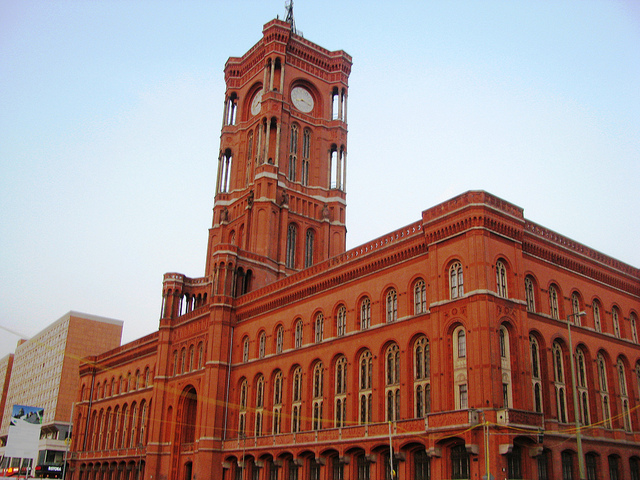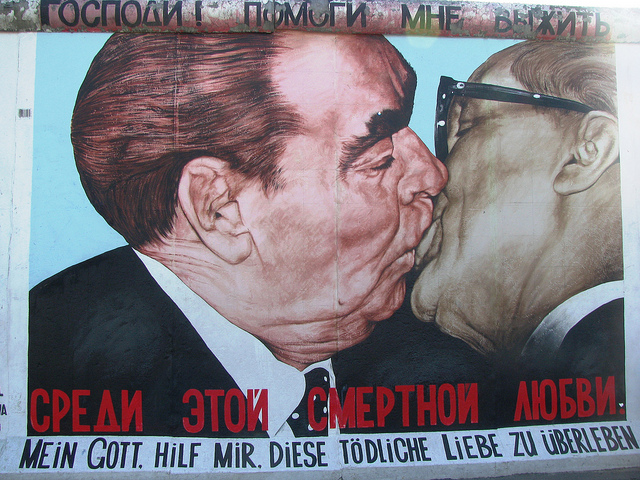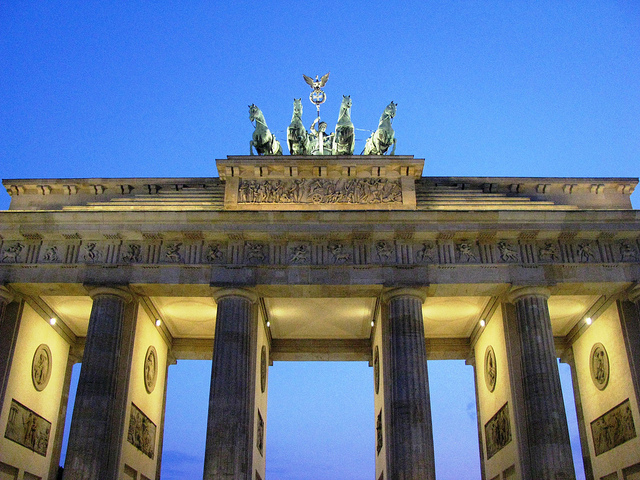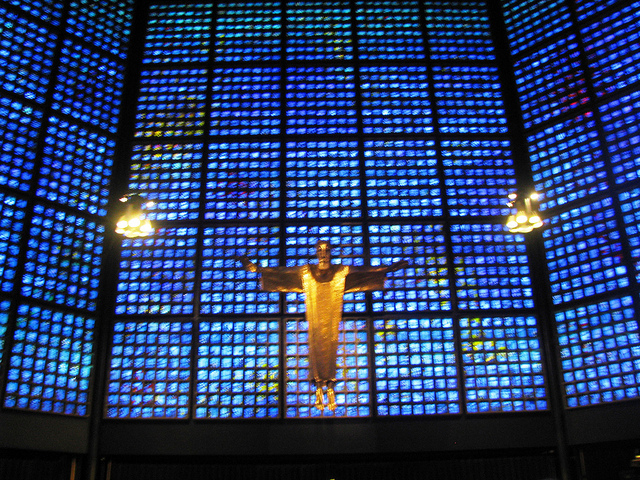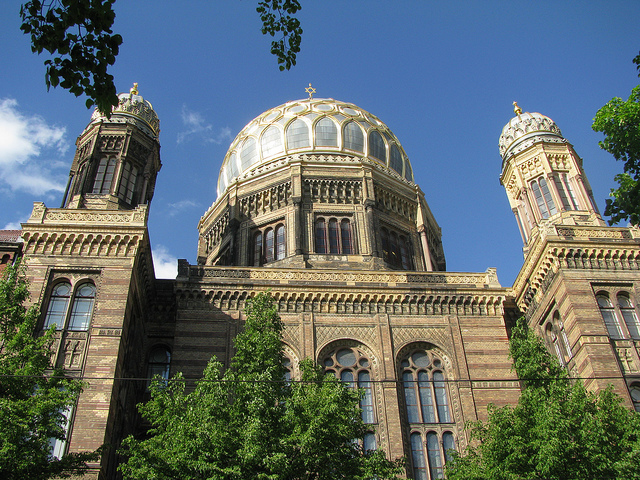Back on land after my initial Spree River boat tour, I headed off on foot across the Karl-Liebknecht Strasse past the historic 13th century Marienkirche (St. Mary’s Church) into the Nikolaiviertel, the oldest part of Berlin. I passed the iconic Red City Hall (“Rotes Rathaus”), one of Berlin’s most well-known buildings. This imposing red brick Neo-Renaissance construction was opened in 1869 and is still home to Berlin’s city government.

Now inside the Nikolaiviertel, I admired historic-looking buildings that were reconstructed between 1979 and 1987 as most of Berlin had been completely destroyed during the Second World War. While the East German government had decided to raze and rebuild large parts of East Berlin, it decided to re-create a medieval village right here in the area where Berlin was founded. All the buildings there are replicas of original historic buildings. The Nikolaikirche (St. Nicholas Church) is in the heart of the quarter and was also rebuilt in 1987, to re-create the original church that was erected around 1230. In Berlin, the lingering scars of WWII are ever palpable, even in the reconstruction of historic buildings that were bombed out during the war.
I had a quick dinner of asparagus soup in a nearby restaurant; all the local eateries were promoting “asparagus week”, as white asparagus is a very popular delicacy in Germany. Then it was back out into the spring night and I headed back westwards past the Cathedral to Unter den Linden (“under the linden trees”), Berlin’s most famous boulevard that connects the Lustgarten Platz with the Brandenburg Gate.
Numerous historic buildings frame the boulevard, the Berlin State Opera, Humboldt University, St. Hedwig’s Cathedral as well as the Russian and Hungarian embassies. Finally I had reached the Brandenburg Gate, Berlin’s most famous icon. This former city gate is a Neo-Classical masterpiece that was completed in 1795 and modelled after the entrance to the Acropolis in Athens.

The building is crowned by the “Quadriga”, a sculpture of a chariot that is drawn by four horses. Originally a symbol of peace, the sculpture was dismantled and taken to Paris during Napoleon’s occupation in 1806. It was returned in 1814 after the allied victory over Napoleon. In 1933 the Nazis celebrated their ascent to power with a torch-lit parade underneath the Brandenburg Gate. During the fight for Berlin in WWII the Quadriga was seriously damaged, but fortunately a plaster cast had been made a few years earlier which was used during its reconstruction in 1956.
During the period of the divided Germany, the Brandenburg Gate was right in the middle of the prohibited zone and could not be accessed from either East or West Berlin. Only East Germany military personnel and state visitors of East Germany were able to access the structure. On June 12, 1987, US President Ronald Reagan spoke the famous words “Mr. Gorbachev, open this gate! Mr. Gorbachev, tear down this wall!” Finally after reunification, the Brandenburg Gate was opened again on December 22, 1989. This monument has been at the heart of some of the most significant events in German history.
Today, Pariser Platz, the square in front of the Brandenburg Gate, has been completely transformed. What once used to be a restricted military zone today has been redeveloped and holds the US Embassy, the head office of Deutsche Bank, the Academy of Fine Arts and the Adlon Hotel. Various street performers plied their trade, and a young gentleman with a really fascinating bicycle contraption was looking for business. A round bicycle with six seats all arranged in a circle was waiting for customers, and I was one of them. The charming young entrepreneur convinced me to get on the ride together with four other travellers, and for 2 Euros we circled once around Pariser Platz. It was a short ride, but a heck of a lot of fun and a totally different experience…

Continuing my exploration of German history, I headed to the Reichstag, a Neo-Renaissance building that was built between 1884 and 1894 as the German parliament. The famous inscription “Dem Deutschen Volke” (“To the German People”) was added in 1916. On February 27, 1933, the building caught fire and allowed the Nazis to suspend most of the rights that had been granted in the 1919 Weimar Constitution, setting the tone for the totalitarian regime that was to reign for 12 horrific years. The Nazis actually did not use the building for parliamentary purposes, and only used it for propaganda events.
Propagandist Nazi exhibitions such as “The Eternal Jew” and “Bolshewism without the Mask” were held in this building. Even Hitler’s models of “Germania, the world capital”, his deluded megalomaniac dream of a reconstructed German capital, were exhibited here. Heavily damaged, the building was finally occupied by the Russian Army after three days of heavy fights on May 1, 1945 during the Battle of Berlin.
During the time of the divided Germany, the Reichstag was part of West Berlin, but the Berlin Wall ran right behind the building and the building was essentially in ruins. After some years during which its future was in doubt, it was decided in 1956 to restore it although many architectural details of the original building were not included in the restoration. The cupola, for example had already been blown up in 1954 for reasons supposedly related to safety.

As a sign of better times, the first meeting of the reunified German parliament was held on December 2, 1990. Finally, the iconic elliptical dome with its viewing gallery, designed by star architect Sir Norman Foster, was added between 1995 and 1999. Today, the Reichstag is the second most visited sight in Berlin.
That’s exactly what I wanted to explore today. It was now after 9 pm and I was lucky to still get access to this iconic building. Following a thorough security check I was able to get into the glass cupola after ascending in two elevators. The dome is 38 meters high and has a slanted ramp takes you ever higher. The main hall of the parliament is visible below, a symbolic gesture of the German parliament’s desire for transparency. The 360 degree view from the dome is magnificent and after ascending to the top of the dome you can walk down and outside to a rooftop terrace that provides an amazing outdoor view of Berlin. The TV Tower was brightly illuminated and Berlin’s highrises and historic buildings were twinkling in the distance.
The visit to the Reichtstag was a fitting end to my first day in Berlin.
